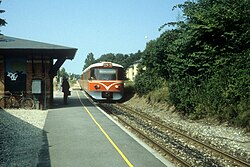Kagerup railway station
Buildings and structures in Gribskov MunicipalityDanish railway station stubsRailway stations in Denmark opened in the 1880sRailway stations in the Capital Region of DenmarkRailway stations opened in 1880

Kagerup railway station is a railway junction located in the central part of the Gribskov forest, about 1 km (0.62 mi) west of the village of Kagerup in North Zealand, Denmark. Kagerup railway station is located on the Gribskov Line. At Kagerup the railway line from Hillerød splits into two branches to the seaside resort towns of Tisvildeleje and Gilleleje. The train services are operated by the railway company Lokaltog which runs frequent local train services from Hillerød station to Tisvildeleje station and Gilleleje station.
Excerpt from the Wikipedia article Kagerup railway station (License: CC BY-SA 3.0, Authors, Images).Kagerup railway station
Kagerup Stationsvej, Gribskov Municipality
Geographical coordinates (GPS) Address Nearby Places Show on map
Geographical coordinates (GPS)
| Latitude | Longitude |
|---|---|
| N 55.9975 ° | E 12.285833333333 ° |
Address
Kagerup Stationsvej 58
3200 Gribskov Municipality
Capital Region of Denmark, Denmark
Open on Google Maps









